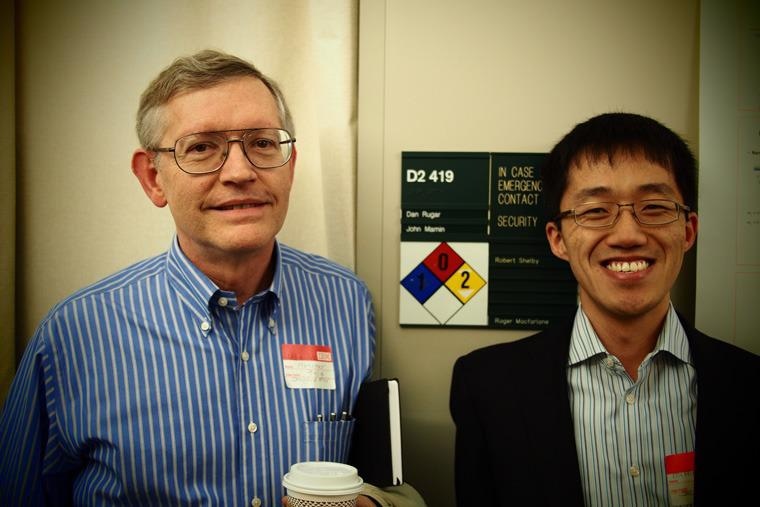Comprehending the basics of molecular interaction in the real, chaotic, dynamic setting of a living body is a challenge that has to be surpassed so as to deal with a variety of diseases, such as Alzheimer’s.
 W.E. Moerner (left) and Matthew Lew at IBM’s Almaden research lab, circa 2014. The two are outside the lab where, in 1989, Moerner first observed single molecules. Image Credit: Washington University in St. Louis.
W.E. Moerner (left) and Matthew Lew at IBM’s Almaden research lab, circa 2014. The two are outside the lab where, in 1989, Moerner first observed single molecules. Image Credit: Washington University in St. Louis.
Scientists have so far been able to capture the motion of one molecule, and they could visualize its rotation — how it tumbles as it collides into neighboring molecules — but only by sacrificing 3D resolution.
Currently, the lab of Matthew Lew, assistant professor of electrical and systems engineering at the McKelvey School of Engineering at Washington University in St. Louis, has formulated an imaging technique that offers an unparalleled look at a molecule as it rotates and rolls through liquid, delivering the most complete picture yet of molecular dynamics captured using optical microscopes.
The study appears in a special issue of the Journal of Physical Chemistry B. The February 17th, 2022, Festschrift is in honor of Nobel laureate William E. (W.E.) Moerner, an imaging pioneer, Washington University alumnus, and mentor to over 100 students over the years, including Lew.
Moerner was the first person to study optical signatures of a single molecule; earlier, scientists did not think it was possible to measure such signals.
Currently, Lew’s lab is the first to visualize the arrangement and direction of a molecule’s rotational movement — how it rotates and wobbles — while it is in a liquid system.
The new imaging technology, known as a vortex microscope, depends on a specific type of light: a polarized optical vortex.
You can bend the light in a certain way so that the photons are spinning along their path.
Matthew Lew, Assistant Professor of Electrical and Systems Engineering, McKelvey School of Engineering, Washington University in St. Louis
Instead of a direct “beam of light,” this optical vortex is formed quite like a corkscrew. It is formed by irradiating light via a helical-shaped lens, the top of which is irregular, sloping downward into a spiral.
The microscope also divides the light into two diverse directions of polarization, offering an understanding of the direction of the wobble of nano-sized light sources, the molecules in the sample.
For their trials, Lew and first author Tianben Ding, then a postdoctoral researcher in Lew’s lab, examined amyloid-beta fibers. Clusters of these proteins, located in the brain, are related to Alzheimer’s disease. The team incorporated fluorescent tracer molecules into the fibers.
The tracers’ job was to examine the surfaces of the amyloid-beta fibers. Every time a tracer collided with a fiber, it produced a light.
The light held information regarding its interaction with the fiber. After it passed via the lens, that information was deduced by an algorithm prepared by Lew’s team.
An optical vortex is not a “point” of light, but it is spread out more like a donut. Based on the donut’s features — is it stretched out along a definite axis, or darker in certain places? — the algorithm can deduce seven diverse properties of the tracer molecule, including its direction and position.
Since the researchers used a polarized optical vortex, they also can establish the direction of the wobble, a unique ability of the vortex microscope.
The ways in which the molecule interrelates with the fiber can, consecutively, help provide a picture of the motion and topology of the fiber.
In summary, the vortex microscope delivers a comprehensive look into the interaction among the surfaces of these amyloid-beta fibers — the way they bounce off each other or attach — and how their surfaces impact whether or not they start to aggregate.
This is the first time we can measure these very detailed dynamics of how molecules move and rotate inside liquid systems.
Matthew Lew, Assistant Professor of Electrical and Systems Engineering, McKelvey School of Engineering, Washington University in St. Louis
Light Surprise
Lew said he and Ding were amazed when a computer simulation recommended an optical vortex might open up a chance to view motion and details simultaneously.
In our field, we’re always trying to think about concentrating the light because our light sources are so weak. It was surprising that spreading the light out into a donut shape would be useful at all.
Matthew Lew, Assistant Professor of Electrical and Systems Engineering, McKelvey School of Engineering, Washington University in St. Louis
Journal Reference:
Ding, T. & Lew, M.D. (2022) Single-Molecule Localization Microscopy of 3D Orientation and Anisotropic Wobble Using a Polarized Vortex Point Spread Function. Journal of Physical Chemistry B. doi.org/10.1021/acs.jpcb.1c08073.